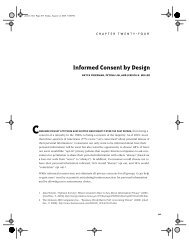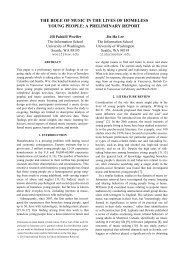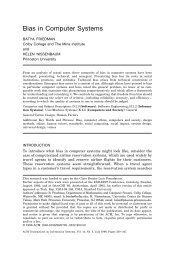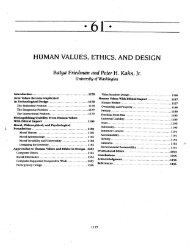Value Scenarios: A Technique for Envisioning Systemic Effects of ...
Value Scenarios: A Technique for Envisioning Systemic Effects of ...
Value Scenarios: A Technique for Envisioning Systemic Effects of ...
Create successful ePaper yourself
Turn your PDF publications into a flip-book with our unique Google optimized e-Paper software.
CHI 2006 2007 ·• Work-in-Progress<br />
April 28-May 3, 2007 • San Jose, CA, USA<br />
<strong>Value</strong> <strong>Scenarios</strong>: A <strong>Technique</strong> <strong>for</strong><br />
<strong>Envisioning</strong> <strong>Systemic</strong> <strong>Effects</strong> <strong>of</strong> New<br />
Technologies<br />
Lisa P. Nathan<br />
In<strong>for</strong>mation School<br />
University <strong>of</strong> Washington<br />
Seattle, WA 98110 USA<br />
lpn@u.washington.edu<br />
Predrag V. Klasnja<br />
In<strong>for</strong>mation School<br />
University <strong>of</strong> Washington<br />
Seattle, WA 98110 USA<br />
klasnja@u.washington.edu<br />
Batya Friedman<br />
In<strong>for</strong>mation School<br />
University <strong>of</strong> Washington<br />
Seattle, WA 98110 USA<br />
batya@u.washington.edu<br />
Abstract<br />
In this paper we propose that there is a scarcity <strong>of</strong><br />
methods which support critical, systemic, long-term<br />
thinking in current design practice, technology<br />
development and deployment. To address this need we<br />
introduce value scenarios, an extension <strong>of</strong> scenariobased<br />
design which can support envisioning the<br />
systemic effects <strong>of</strong> new technologies. We identify and<br />
describe five key elements <strong>of</strong> value scenarios:<br />
stakeholders, pervasiveness, time, systemic effects,<br />
and value implications. We provide two examples <strong>of</strong><br />
value scenarios, which draw from our current work on<br />
urban simulation and human-robot interaction. We<br />
conclude with suggestions <strong>for</strong> how value scenarios<br />
might be used by others.<br />
Keywords<br />
<strong>Value</strong> <strong>Scenarios</strong>, scenario-based design, <strong>Value</strong><br />
Sensitive Design, design noir, design method<br />
Copyright is held by the author/owner(s).<br />
CHI 2007, April 28–May 3, 2007, San Jose, Cali<strong>for</strong>nia, USA.<br />
ACM 978-1-59593-642-4/07/0004.<br />
ACM Classification Keywords<br />
K 4.1 Computers and Society (Public Policy); K 4.2<br />
Computers and Society (Social Issues)<br />
2585
CHI 2006 2007 ·• Work-in-Progress<br />
April 28-May 3, 2007 • San Jose, CA, USA<br />
Introduction<br />
As millions <strong>of</strong> cell phones, personal computers, and<br />
other high tech devices become outdated, a range <strong>of</strong><br />
organizations and government agencies are attempting<br />
to stanch the flow <strong>of</strong> toxic materials into the planet’s<br />
waste streams. How might this daunting<br />
environmental crisis, tied to technological waste, have<br />
been avoided More generally, how might we support<br />
envisioning the diverse effects <strong>of</strong> a new technology<br />
when it enters a societal milieu<br />
Our work is grounded in a theoretical view <strong>of</strong><br />
technological appropriation, which is deeply<br />
interactional [7]. From this viewpoint, the influence<br />
that a new technology has on the world is not solely<br />
determined by the technology’s design and the<br />
purposes behind it. Rather, shaped by its <strong>for</strong>m and<br />
content, by individuals, and society at large, a<br />
technology can be appropriated in a multitude <strong>of</strong> ways.<br />
The consideration <strong>of</strong> technological appropriations, along<br />
with the new <strong>for</strong>ms <strong>of</strong> social and cultural interactions<br />
that arise alongside them, should be part and parcel <strong>of</strong><br />
technology development.<br />
Toward this end we introduce value scenarios, an<br />
extension <strong>of</strong> scenario-based design [9] that supports<br />
envisioning the systemic effects <strong>of</strong> new technologies.<br />
<strong>Value</strong> scenarios build upon the narrative structure <strong>of</strong><br />
traditional scenario-based design and combine the<br />
evocative work <strong>of</strong> design noir [7] with the valueoriented<br />
approach <strong>of</strong> <strong>Value</strong> Sensitive Design [8].<br />
We begin by making the claim that systemic thinking<br />
could help designers and policy makers avoid<br />
introducing a technology which may well result in large<br />
environmental, psychological and ethical problems. We<br />
continue with an explicit recognition <strong>of</strong> the challenges<br />
<strong>of</strong> uncertainty, acknowledging that systemic thinking is<br />
difficult. Next we take what we believe are preliminary<br />
steps in identifying and defining key elements to be<br />
considered when developing value scenarios. To<br />
illustrate how these elements may play out, we provide<br />
examples <strong>of</strong> two value scenario projects motivated by<br />
technologies our lab is currently investigating: an urban<br />
simulation system and humanoid robots. We conclude<br />
by <strong>of</strong>fering suggestions <strong>of</strong> the circumstances under<br />
which these scenarios might be used to strengthen<br />
design work and facilitate public debate about<br />
technology.<br />
SYSTEMIC THINKING, AND DESIGNING<br />
UNDER UNCERTAINTY<br />
<strong>Systemic</strong> interaction refers to those developments<br />
which either happen at large social scales or those that<br />
have large-scale effects that go beyond the initial locus<br />
<strong>of</strong> the interaction. <strong>Systemic</strong> effects are <strong>of</strong>ten emergent;<br />
they develop as increasingly more local interactions<br />
take place.<br />
While value scenarios support the envisioning <strong>of</strong><br />
systemic interactions, we do not claim to be predicting<br />
the future. It is not possible to consider all potential<br />
outcomes when a new technology enters a cultural and<br />
societal milieu. However, we are inspired by the line <strong>of</strong><br />
thought put <strong>for</strong>ward by Hannah Arendt who insisted<br />
that in the face <strong>of</strong> uncertainty we attempt “nothing<br />
more than to think what we are doing” [1]. Although<br />
the future is uncertain, value scenarios help us think<br />
about how the actions we take today will shape the<br />
conditions <strong>of</strong> our future.<br />
2586
CHI 2006 2007 ·• Work-in-Progress<br />
April 28-May 3, 2007 • San Jose, CA, USA<br />
VALUE SCENARIO FOUNDATIONS<br />
<strong>Value</strong> scenarios extend Carroll and Rosson’s powerful<br />
scenario-based design (SBD) approach [9]. Traditional<br />
SBD uses narrative descriptions <strong>of</strong> individuals<br />
interacting with a technology to stimulate and guide the<br />
design process. These engaging narratives are used to<br />
identify needs, anticipate usability problems, and<br />
facilitate communication among different groups<br />
involved in design and development.<br />
A review <strong>of</strong> SBD literature reveals that a large majority<br />
<strong>of</strong> scenarios created using the traditional SBD<br />
methodology share two key characteristics. The<br />
scenarios typically focus on 1) describing the<br />
functionality <strong>of</strong> a technology under development, and<br />
2) the immediate use <strong>of</strong> the technology by its intended<br />
user-groups [e.g., 2]. While traditional SBD scenarios<br />
describe these aspects <strong>of</strong> a technology quite effectively,<br />
taken together the two characteristics tend to lead the<br />
scenarios in a direction which has a number <strong>of</strong><br />
limitations. First, traditional SBD-type scenarios tend to<br />
portray the technology being utilized in the manner the<br />
designers intended. Moreover the uses are primarily<br />
depicted in a positive light. Second, the scenarios focus<br />
almost exclusively on the direct stakeholders—the<br />
groups that will be in a direct contact with the<br />
technology. Third, traditional scenarios tend to have a<br />
short-term outlook, on the order <strong>of</strong> days or months.<br />
They do not engage issues <strong>of</strong> long-term, emergent use<br />
<strong>of</strong> the technology. Finally, traditional SBD scenarios<br />
seldom take on issues <strong>of</strong> pervasive use. The effects a<br />
particular technology is likely to have if it were to<br />
become pervasive in either a segment <strong>of</strong> society or in<br />
society at large are rarely considered.<br />
An exception to this characterization <strong>of</strong> scenario-based<br />
design is Blythe and Wright’s recent work on pastiche<br />
scenarios [4]. Although engaging, the range <strong>of</strong><br />
consideration <strong>of</strong> the future that pastiche scenarios<br />
make possible can be idiosyncratic and dependent on<br />
the fictional work used to develop the scenario.<br />
Elements <strong>of</strong> <strong>Value</strong> <strong>Scenarios</strong><br />
<strong>Value</strong> scenarios draw upon five key elements to<br />
develop provocative sketches <strong>of</strong> the future:<br />
stakeholders, pervasiveness, time, systemic effects,<br />
and value implications.<br />
Stakeholders: Following <strong>Value</strong> Sensitive Design, value<br />
scenarios help designers envision a range <strong>of</strong> effects <strong>of</strong> a<br />
pervasive technology, both on those who are in direct<br />
contact with a technology (direct stakeholders), and on<br />
those who might not be direct users, but whose lives<br />
are affected by various interactions around the<br />
technology (indirect stakeholders) [7].<br />
Pervasiveness: A value scenario presents a vision in<br />
which a technology has become widespread, spanning<br />
various geographic regions, cultures, social classes, and<br />
other contexts (e.g. school, work, home, car).<br />
Time: Rather than focus on short-term effects, value<br />
scenarios take into consideration what the world might<br />
look like five, ten, or twenty years after a technology<br />
has been deployed.<br />
<strong>Systemic</strong> <strong>Effects</strong>: <strong>Value</strong> scenarios explore the multidimensional<br />
interactions among technology,<br />
psychology, society, culture, and the environment as<br />
use <strong>of</strong> the technology becomes pervasive over a period<br />
<strong>of</strong> years.<br />
2587
CHI 2006 2007 ·• Work-in-Progress<br />
April 28-May 3, 2007 • San Jose, CA, USA<br />
Traditional SBD Scenario<br />
[2007] Sarah and her daughter<br />
Lireal recently moved to the city.<br />
Sarah found a full time job with<br />
decent pay and an apartment<br />
which accepts cats. The one<br />
worry she had left concerned 12-<br />
year-old Lireal walking home<br />
from school alone.<br />
After hearing about SafetyNet on<br />
TV, Sarah purchased a<br />
subscription <strong>for</strong> Lireal’s cellphone.<br />
Sarah used SafetyNet to map out<br />
the safest route to and from<br />
Lireal’s school. Now the<br />
cellphone will emit a warning<br />
tone if Lireal gets too close to a<br />
neighborhood designated as<br />
questionable or dangerous.<br />
<strong>Value</strong> Implications: Finally, drawing on <strong>Value</strong> Sensitive<br />
Design [7] and aspects <strong>of</strong> design noir [6], value<br />
scenarios help envision not only positive effects <strong>of</strong><br />
technology, but also its darker consequences. We<br />
suggest that a careful consideration <strong>of</strong> a diverse range<br />
<strong>of</strong> influences, including the negative, should be a key<br />
component <strong>of</strong> the design process.<br />
ILLUSTRATIVE EXAMPLES<br />
What do value scenarios look like How do they<br />
compare to traditional SBD work Below we <strong>of</strong>fer two<br />
sets <strong>of</strong> examples from our lab’s scenario work. The<br />
first example, SafetyNet, stems from our work with an<br />
open source, large-scale simulation system <strong>for</strong> urban<br />
planning [4]. The second example, Geminoid Jack,<br />
developed in response to a collaborative project with<br />
Advanced Telecommunications Research Institute’s<br />
Intelligent Robotics and Communication Laboratory [8].<br />
Two condensed traditional scenarios are provided in the<br />
margins to help the reader compare the two types <strong>of</strong><br />
scenarios.<br />
SafetyNet<br />
SafetyNet is a hypothetical, commercial s<strong>of</strong>tware<br />
plat<strong>for</strong>m which leverages publicly available<br />
demographic and criminal data, mapping technology,<br />
and satellite-tracking capabilities to create maps <strong>for</strong><br />
display on various mobile technologies (e.g., cell<br />
phones, blackberries, in-car navigational systems).<br />
These maps are used to alert urban travelers as they<br />
venture into potentially unpleasant or dangerous areas<br />
during their travels.<br />
<strong>Value</strong> Scenario: Canbaro lives in a SafetyNet world, yet<br />
has never actually used the device. Her mother says<br />
SafetyNet keeps strangers out <strong>of</strong> the neighborhood.<br />
Yet, Canbaro has overheard her father complaining that<br />
since SafetyNet labels their neighborhood as poor and<br />
Somali, only poor Somalis move in. Neighbors joke that<br />
if a new car comes down the street, its SafetyNet must<br />
be busted. Canbaro’s little brother is convinced that<br />
SafetyNet is a real net which encircles their<br />
neighborhood. Canbaro wonders whom the net is<br />
supposed to catch.<br />
The 204 th street gang has figured out the answer to<br />
Canbaro’s question. They regularly use SafetyNet to<br />
locate the home <strong>of</strong> the “catch” d’jour. For years<br />
homebuyers have been using SafetyNet to find decent<br />
neighborhoods, filled with people like themselves. As a<br />
result, the city has become segregated into<br />
homogenous enclaves. Thus, whether they are seeking<br />
to revenge themselves on a Chinese person or<br />
someone <strong>of</strong> Mexican descent, the demographic<br />
in<strong>for</strong>mation is just a few clicks away. SafetyNet is the<br />
ultimate pr<strong>of</strong>iling tool.<br />
SafetyNet Discussion<br />
The SafetyNet value scenario provides a vision <strong>of</strong> how<br />
the technology might influence the lives <strong>of</strong> both indirect<br />
(Canbaro) and direct stakeholders (home buyers and<br />
the street gang) as SafetyNet becomes pervasive.<br />
Canbaro hasn’t used the technology, but her<br />
neighborhood has clearly been influenced by others’<br />
use <strong>of</strong> the technology. <strong>Value</strong>s such as diversity and desegregation<br />
appear to have been left behind as the<br />
technology enables people to easily avoid commuting<br />
through or living in areas <strong>of</strong> the city they find<br />
uncom<strong>for</strong>table. <strong>Systemic</strong> interactions over time have<br />
created a city which has become segregated to a level<br />
previously unimagined. The gangs’ appropriation <strong>of</strong> the<br />
2588
CHI 2006 2007 ·• Work-in-Progress<br />
April 28-May 3, 2007 • San Jose, CA, USA<br />
Traditional SBD Scenario:<br />
[2007] Jack is beyond excited.<br />
Today, through his geminoid<br />
Jack-G, he can truly contribute to<br />
a class debate through his voice,<br />
his hand gestures, and his facial<br />
expressions. By connecting to<br />
the geminoid’s control system,<br />
Jack experiences real-time sights<br />
and sounds from the classroom.<br />
However, what is far more<br />
empowering is <strong>for</strong> Jack to actively<br />
participate in this environment.<br />
He can share his thoughts with<br />
classmates through Jack-G’s<br />
voice and body language.<br />
technology suggests nefarious activities that the<br />
“current” iteration <strong>of</strong> SafetyNet could easily support.<br />
Geminoid Jack<br />
The term geminoid has been coined by leading<br />
roboticist Hiroshi Ishiguro [8] to mean an android twin<br />
<strong>of</strong> a human “master”. A current version <strong>of</strong> the<br />
geminoid is controlled via a motion capture system<br />
which tracks the master’s movements and enables the<br />
remote controlled geminoid to mimic mouth and body<br />
movements while transmitting voice and audio signals.<br />
<strong>Value</strong> Scenario: [2011] Jack was born with severe<br />
combined immunodeficiency syndrome (SCIDS) and <strong>for</strong><br />
17 years he has been physically isolated in his sterile<br />
bedroom. His parents purchased a geminoid, Jack-G,<br />
four years ago so Jack could “attend” school. Today<br />
there are more geminoids in the school hallways,<br />
classrooms, and playing fields than humans. No longer<br />
used solely in specialized circumstances, geminoids<br />
have become massively popular <strong>for</strong> those who can<br />
af<strong>for</strong>d them. Only poor kids and a few really ancient<br />
teachers attend school in “flesh mode” anymore. These<br />
geminoids are easy to distinguish because they are<br />
truly visions <strong>of</strong> humanoid perfection. No longer<br />
conceptualized as physical twins <strong>of</strong> their masters,<br />
geminoids are now created with blemish free skin,<br />
sculpted bodies, and fashionably styled hair.<br />
Last month, after a strict regimen <strong>of</strong> cutting-edge<br />
meds, Jack was diagnosed SCIDS free. He could even<br />
go to school, but none <strong>of</strong> his healthy peers attend<br />
anymore. Moreover, his mother is against it. She says<br />
the world is changing and right now he is actually<br />
ahead <strong>of</strong> his peers because he is so adept at controlling<br />
Jack-G. If he stops using the controls on a daily basis,<br />
he may lose his advantage. As Jack looks in the mirror<br />
he suspects that she is also worried that his physical<br />
condition after years <strong>of</strong> sitting at Jack-G’s controls<br />
instead <strong>of</strong> doing the exercises prescribed by his<br />
physical therapist. No sculpted perfect body here.<br />
Mom is probably right; most <strong>of</strong> his friends are spending<br />
entire days in their rooms, just like Jack. Even Jack’s<br />
little brother, Joey, is getting pretty good with his<br />
geminoid. Actually Joey is becoming so used to<br />
engaging in geminoid play-dates from the com<strong>for</strong>t <strong>of</strong><br />
his own room that he no longer likes to physically go to<br />
his best friend’s house.<br />
Geminoid Discussion<br />
The value scenario takes a peek into a future society in<br />
which geminoids are ubiquitous. The pervasiveness <strong>of</strong><br />
geminoids opens the imagination <strong>of</strong> the reader to a<br />
wide range <strong>of</strong> implications. The introduction <strong>of</strong><br />
physically superior geminoids hints at appropriations<br />
that were not part <strong>of</strong> the original design motivation.<br />
The brief mention <strong>of</strong> indirect stakeholders (poor<br />
students and ancient teachers), those who do not<br />
directly own or operate a geminoid, also brings to mind<br />
issues <strong>of</strong> prejudice and inequity. Mention <strong>of</strong> physical<br />
atrophy alerts us to the effects <strong>of</strong> physical adaptation<br />
and stimulates consideration <strong>of</strong> the types <strong>of</strong><br />
adaptations that are supported by the design.<br />
We note that a strong negative tone is tangible in both<br />
value scenarios. A noir portrayal provides a<br />
counterbalance to the tendency <strong>of</strong> technologists to<br />
focus on the positive when considering their latest<br />
project.<br />
2589
CHI 2006 2007 ·• Work-in-Progress<br />
April 28-May 3, 2007 • San Jose, CA, USA<br />
CONCLUSION AND DESIGN IMPLICATIONS<br />
As our examples begin to illustrate, through value<br />
scenarios, designers and policy makers can begin to<br />
imagine a wide range <strong>of</strong> influences <strong>for</strong> a proposed<br />
technology. The design team and/or policy makers are<br />
assisted in considering various appropriations which can<br />
be supported or constrained by system and policy<br />
implementations.<br />
We have two suggestions <strong>for</strong> when value scenarios<br />
might be used. The first is during early strategic<br />
planning <strong>of</strong> technology development projects be<strong>for</strong>e<br />
time and money is invested. Secondly, value scenarios<br />
could be used as touchstones during policy-making<br />
discussions and the public discourse that surrounds<br />
them. We do not intend <strong>for</strong> the types <strong>of</strong> scenarios we<br />
describe in this paper to be used isolation, nor is the<br />
list <strong>of</strong> elements we provide exhaustive. <strong>Value</strong> scenarios<br />
do not predict the future; instead value scenarios<br />
leverage an extraordinary human capability, our ability<br />
to adjust our actions based on contemplation <strong>of</strong> the<br />
future. As Dubos wrote, “Indeed, man’s propensity to<br />
imagine what does not yet exist, including what will<br />
never come to pass, is the aspect <strong>of</strong> his nature which<br />
most clearly differentiates him from animals. The more<br />
human he is, the more intensely do his anticipations <strong>of</strong><br />
the future affect the character <strong>of</strong> his responses to the<br />
<strong>for</strong>ces <strong>of</strong> the present”[5]. Given the far-reaching<br />
influences that technology has on our world, imagining<br />
possible futures is particularly important during<br />
technology development. <strong>Value</strong> scenarios provide a<br />
technique <strong>for</strong> moving in that direction.<br />
ACKNOWLEDGEMENTS<br />
This material is based, in part, upon work supported by<br />
the National Science Foundation under Grant No.<br />
0325035. Any opinions, findings, and conclusions or<br />
recommendations expressed in this material are those<br />
<strong>of</strong> the authors and do not necessarily reflect the views<br />
<strong>of</strong> the National Science Foundation.<br />
REFERENCES<br />
[1] Arendt, H. The human condition. Chicago<br />
University Press, Chicago, IL, USA, 1958.<br />
[2] Benyon, D. and Macaulay, C. <strong>Scenarios</strong> and the<br />
HCI-SE design problem. Interacting with Computers,<br />
14, (2002), 397-405.<br />
[3] Blythe, M. A., & Wright, P. C. Pastiche scenarios:<br />
Fiction as a resource <strong>for</strong> user centered design.<br />
Interacting with Computers, 18, 5 (2006), 1139-1164.<br />
[4] Borning, A., Waddell, P., and Förster, R. UrbanSim:<br />
Using simulation to in<strong>for</strong>m public deliberation and<br />
decision making.<br />
http://www.urbansim.org/papers/borning-urbansimcase-study-2006.pdf.<br />
[5] Dubos, R. (1980). Man Adapting. Yale University<br />
Press, Boston, MA, USA, 7.<br />
[6] Dunne, A., & Raby, F. Design Noir: The secret life<br />
<strong>of</strong> electronic objects. August Media, Boston, MA, USA,<br />
2001.<br />
[7] Friedman, B., Kahn, P. H., Jr., and Borning, A.<br />
<strong>Value</strong> Sensitive Design and in<strong>for</strong>mation systems. In Z.<br />
Ping and D. Galletta (Eds.), Human-Computer<br />
Interaction and Management In<strong>for</strong>mation Systems:<br />
Foundations. M.E. Sharpe, Inc., Armonk, NY, USA,<br />
2006, 348-372.<br />
[8] Intelligent Robotics and Communication<br />
Laboratory. http://www.irc.atr.jp/index.html<br />
[9] Rosson, M. B., and Carroll, J. M. Scenario-based<br />
design. In J. A. Jacko & A. Sears (Eds.), The humancomputer<br />
interaction handbook: Fundamentals,<br />
evolving technologies, and emerging applications.<br />
Mahwah, NJ, USA, 2003, 1032-1050.<br />
2590






